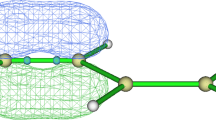Abstract
Bonding criteria for molecular orbitals in diatomic molecules are discussed. An orbital force criterion is shown to have several conceptual and practical advantages, providing a basis for the investigation of inter-relations among many of the commonly employed criteria.
It is found that interconsistency among those criteria is guaranteed, within the framework of Koopmans' Theorem, if the orbital energies are monotonic in the range (R e, ∞).
The application of the orbital force criterion to the second row homonuclear diatomics exhibits reasonable chemical trends concerning the valence-shell orbitals, as well as indications of a slightly antibonding nature of the inner orbitals.
Similar content being viewed by others
References
Mulliken, R. S., in: Quantum theory of atoms, molecules and solid state, P. O. Löwdin, Ed., and references therein. New York: Academic Press 1966
Hurley, A. C., in: Molecular orbitals in chemistry, physics and biology, P. O. Löwdin and B. Pullman Eds. New York: Academic Press 1964
Price, W. C.: Advan. At. Mol. Phys.10, 131 (1974)
Feinberg, M. J., Ruedenberg, K., Mehler, E. L.: Advan. Quantum Chem.5, 27 (1970)
See, e.g., Coulson, C. A.: Valence. London: Oxford University Press 1961
Eyring, H., Walter, J., Kimball, G. E.: Quantum chemistry, p. 208. New York: John Wiley & Sons 1967
Mulliken, R. S.: Intern., J. Quantum Chem.8, 817 (1974); Ermler, W. C., Mulliken, R. S., Wahl, A. C.: J. Chem. Phys.66, 3031 (1977)
Berlin, T.: J. Chem. Phys.19, 208 (1951)
Bader, R. F. W., Henneker, W. H., Cade, P. E.: J. Chem. Phys.46, 3341 (1967)
Slater, J. C., Mann, J. B., Wilson, T. M., Wood, J. H.: Phys. Rev.184, 672 (1969)
Goscinski, O., in: Quantum science — methods and structure, J.-L. Calais, O. Goscinski, J. Linderberg, Y. N. Öhrn, Eds. New York: Plenum Press 1976; Goscinski, O., Palma, A.: Chem. Phys. Letters47, 322 (1977)
Fraga, S., Ransil, B. J.: J. Chem. Phys.35, 1967 (1961)
Ransil, B. J.: J. Chem. Phys.34, 2109 (1961)
Clementi, E., Popkie, H.: J. Chem. Phys.57, 4870 (1972)
Nesbet, R. K.: J. Chem. Phys.40, 3619 (1964)
Fraga, S., Ransil, B. J.: J. Chem. Phys.35, 669 (1961)
Clark, D. T., Muller, J.: Theoret. Chim. Acta (Berl.)41, 193 (1976)
Herzberg, G.: Spectra of diatomic molecules. Princeton: Van Nostrand 1950
Rosen, B.: Spectroscopic data relative to diatomic molecules. Oxford: Pergamon Press 1970
Author information
Authors and Affiliations
Additional information
Based on a section of a thesis to be submitted by Y.T. to the Senate of the Technion-Israel Institute of Technology, in partial fulfilment of the requirements for the D.Sc. degree
Rights and permissions
About this article
Cite this article
Tal, Y., Katriel, J. Bonding criteria for diatomic molecular orbitals and inter-relations among them. Theoret. Chim. Acta 46, 173–181 (1977). https://doi.org/10.1007/BF00578227
Received:
Issue Date:
DOI: https://doi.org/10.1007/BF00578227




